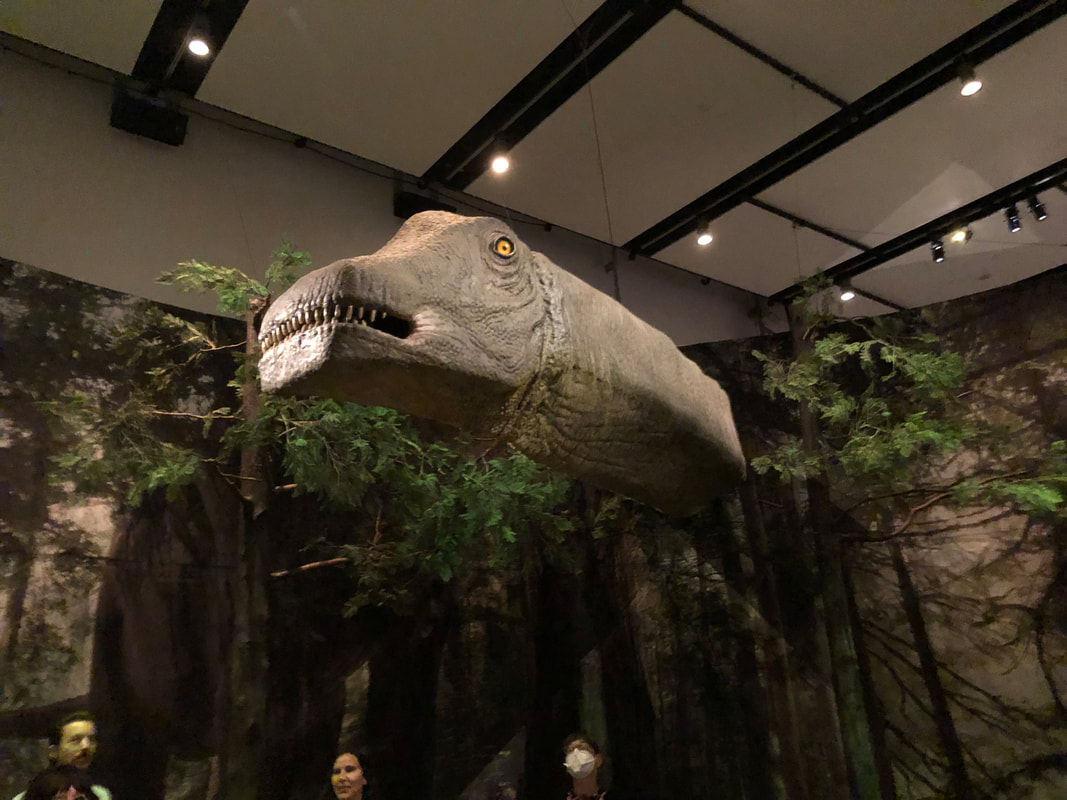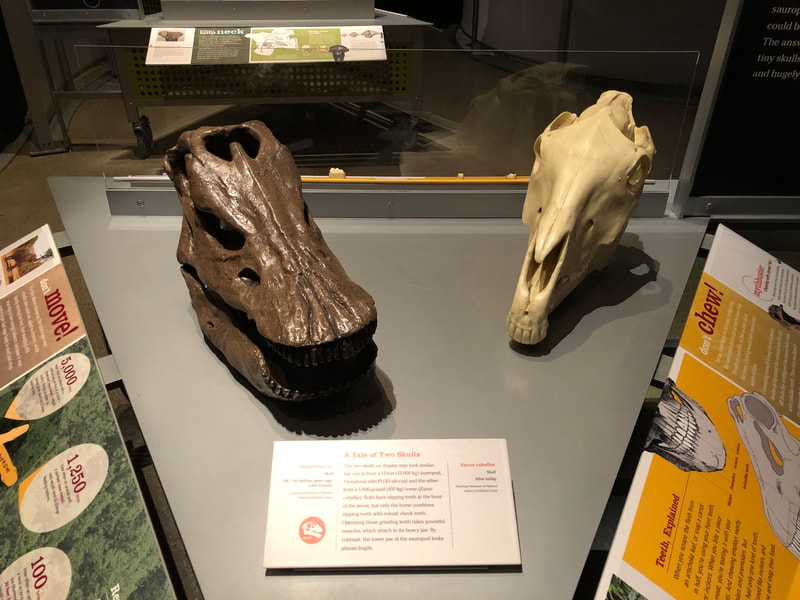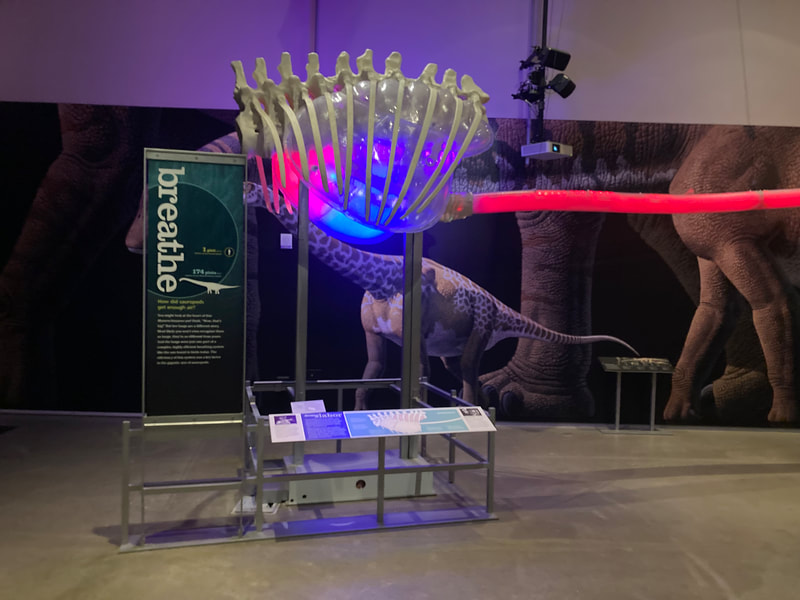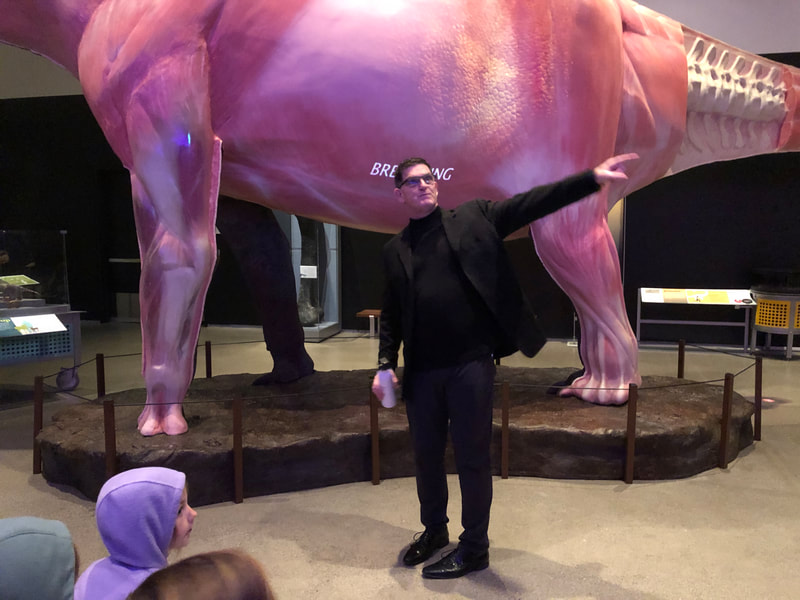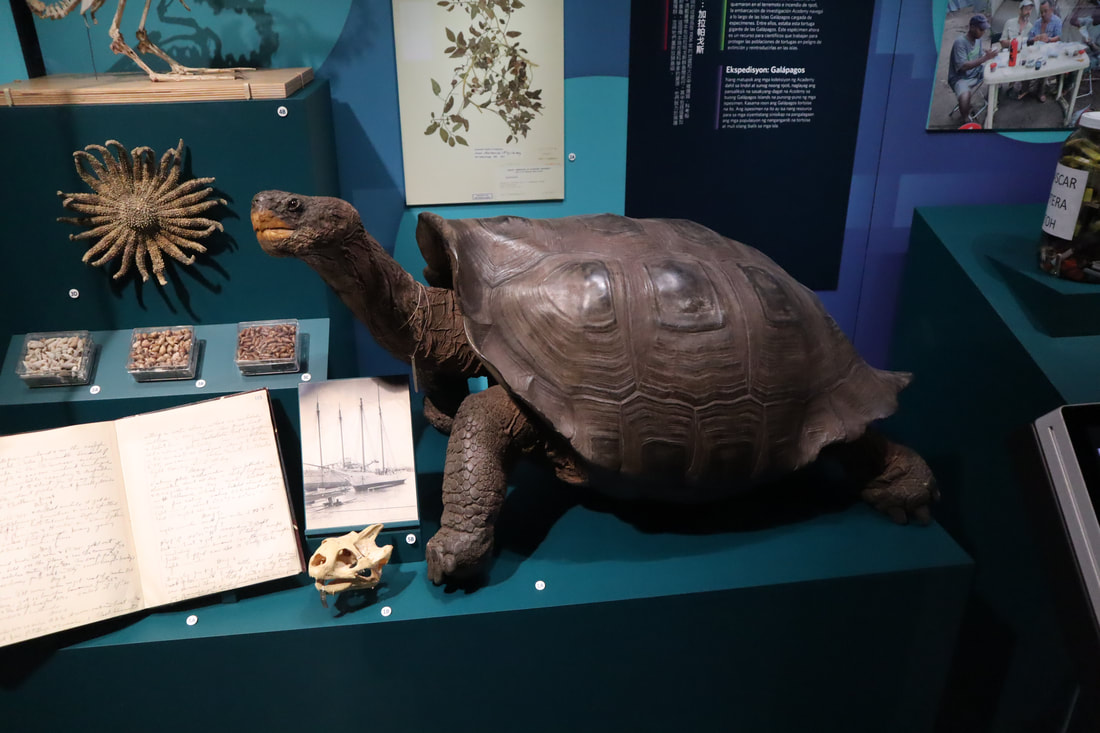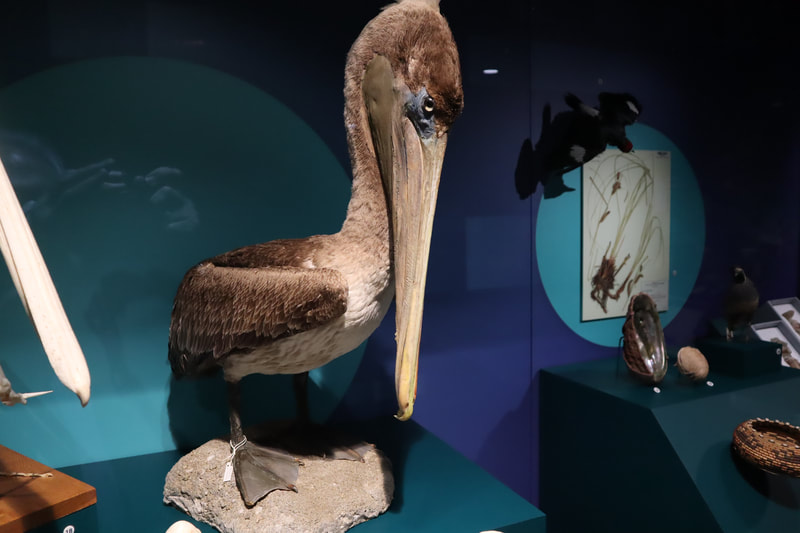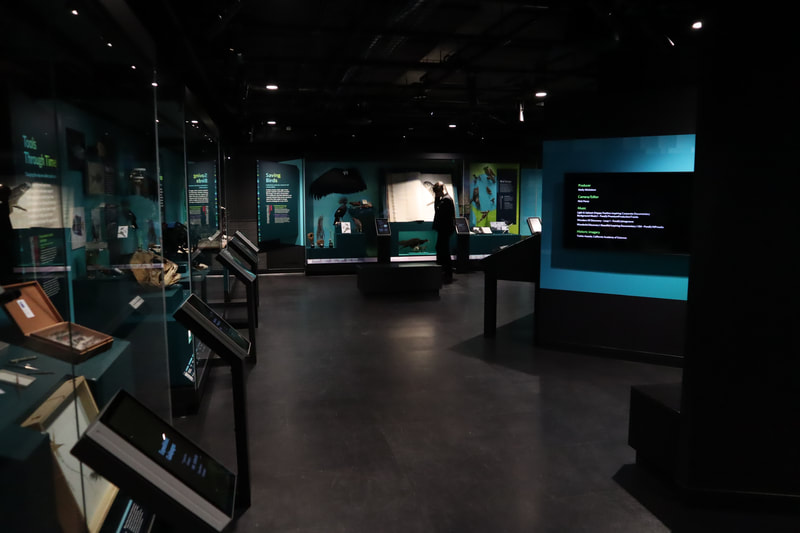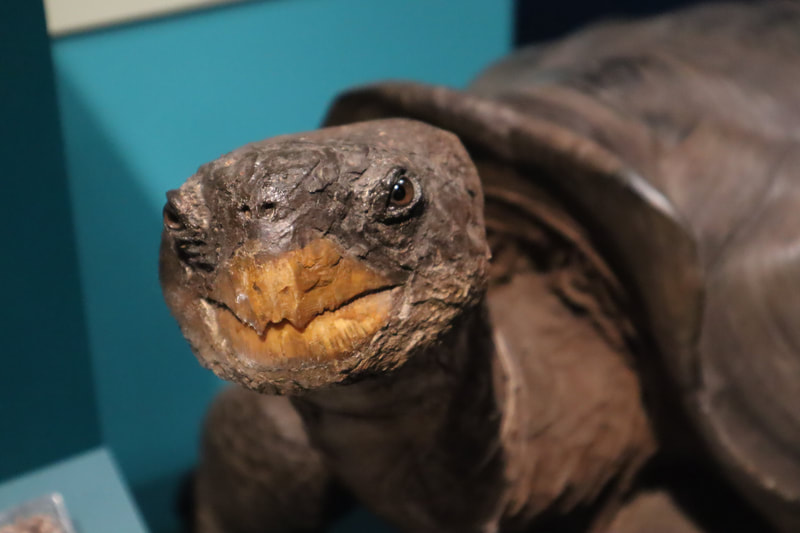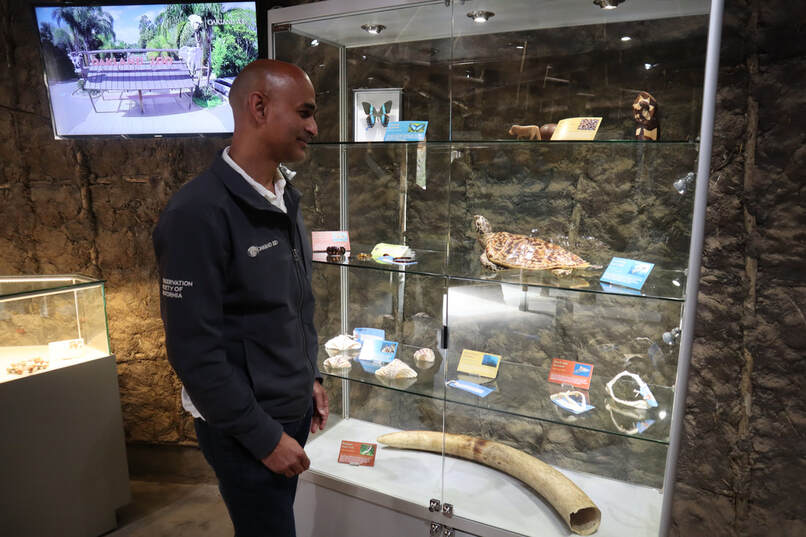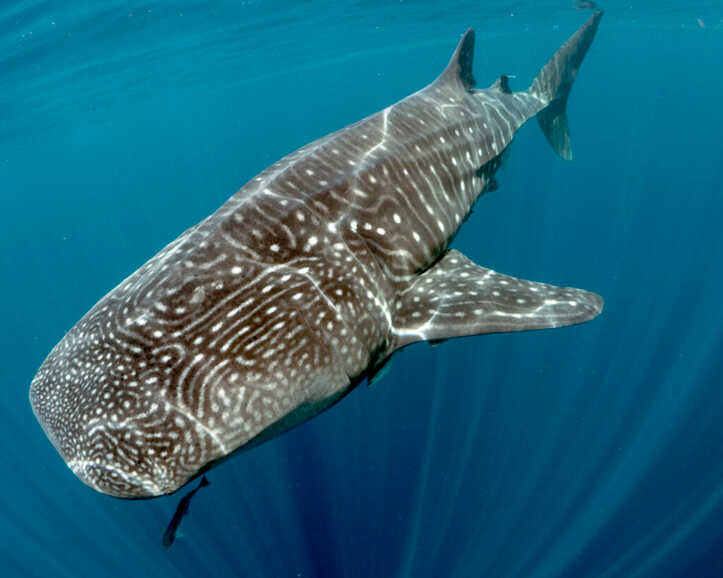May 25, 2024
California's natural resources put on display
Visitors view "California:State of Nature" the newest exhibit at the California Academy of Sciences
Dave Boitano/photo
Dave Boitano/photo
California may have traffic, high taxes and unaffordable housing, but there is one element the state can point to with pride: it is a land of incomparable environments containing some of the most unique plants and animals found anywhere.
Proof of the state’s biodiversity can be found in “California: State of Nature” the newest exhibit at the California Academy of Sciences in San Francisco’s Golden Gate Park. While natural history displays are common in many of the state’s museums, State of Nature goes further by showing the connection between people, places and species found in forests, coasts, deserts and cities.
The exhibit takes up a portion of the building’s west hall which was home to a previous display “Giants of Land and Sea.” Some objects, including a huge blue whale skeleton, a shake house and a 900-year old redwood tree section were held over.
But this time, the emphasis is on the entire state not just Northern California. Visitors will learn how academy researchers, other scientists and community groups participate in studying and preserving California’s natural resources and heritage.
The exhibit is also an outgrowth of the academy’s Thriving California initiative, a plan aimed at restoring biodiversity, combatting climate change, and ensuring equal access to nature for all state residents.
“Some people think that you have to go to a tropical rainforest to see this array of plants and animals, said Paige Laduzinsky, senior exhibit content developer.
“But here in California we have many, many species that are found nowhere else on Earth. This is getting people more connected to what is happening in their home state.”
The exhibit blends animal specimens, the latest in touch screen video technology, models and original art into a unique museum experience.
Along with the usual staff of graphic artists, model makers and scientists, content staff also involved indigenous Ohlone and Yurok tribes in producing the exhibit. Their contributions are apparent in a large video explaining how Native Americans used controlled fires to get rid of the flammable forest undergrowth that fuels most of today’s forest fires.
“We wanted to talk about fire in this exhibit because California is so known for these catastrophic wildfires,” Laduzinsky said. “We wanted to reframe fire when it can be good and healthy,” she said, adding that burning clears the way for new plants to sprout.
Many displays reflect complex stories of conservation or the exploitation of wildlife.
None more so than “Monarch,” one of California’s last grizzly bears captured before the species went extinct in 1924. The bear was put on live display by William Randolph Hearst as a publicity stunt. He was named for Hearst’s San Francisco Examiner newspaper whose motto was “Monarch of the dailies.”
Unfortunately, Monarch lived out his life in a small Golden Gate Park cage before his death and acquisition by the academy.
He is kept in a darkened case, partly to emphasize the tragedy of extinction, but also to preserve his appearance. When put on display 12 years ago, Monarch’s fur faded due to exposure to sunlight. Display technicians restored the color and made certain that his case can be checked to ensure the proper temperature, humidity and light levels, according to Julia Louie, lead designer for “California: State of Nature.
A Grizzly adorns Calfornia’s state flag, but the species was hunted to extinction during the Gold Rush. Though his story is sad, the bear’s fate can spark discussions on how this unique species could make a comeback.
“Monarch is a really good example of how to change our practice when we think about a species going forward, “Laduzinsky said. “There are some offers to study the feasibility of bringing grizzlies back to California. The academy works with the California Grizzly Research Network in looking at what it might take to create the successful return to the state.”
Most scientists study animals in the wild, but the new emphasis on how wildlife survives within cities is also part of this exhibit.
Raccoons are frequent night visitors to Golden Gate Park, and scientists are testing their problem-solving ability with treat -filled puzzle boxes. One is on display for the public to see if visitors are smarter than a raccoon.
A coyote specimen on display nearby died when hit by a car on Interstate 280 in the summer of 2023. Such accidents are common and speak to the need for connected pathways or tunnels around human barriers to help migrating animals.
Guests can experience firsthand what it’s like to use a pathway, by crawling through an exhibit mock-up complete with traffic noises. A closed-circuit camera records the experience and displays a video on a screen alongside black and white scenes taken with remote wildlife cameras.
California: State of Nature will remain on display for around five years. Laduzinsky hopes it will convince the public that nature is deserving of our protection and seek out ways to help out.
“We can all pitch in to make California healthier,” she said. “It’s a big bowl of biodiversity that is filled with nature.”
Proof of the state’s biodiversity can be found in “California: State of Nature” the newest exhibit at the California Academy of Sciences in San Francisco’s Golden Gate Park. While natural history displays are common in many of the state’s museums, State of Nature goes further by showing the connection between people, places and species found in forests, coasts, deserts and cities.
The exhibit takes up a portion of the building’s west hall which was home to a previous display “Giants of Land and Sea.” Some objects, including a huge blue whale skeleton, a shake house and a 900-year old redwood tree section were held over.
But this time, the emphasis is on the entire state not just Northern California. Visitors will learn how academy researchers, other scientists and community groups participate in studying and preserving California’s natural resources and heritage.
The exhibit is also an outgrowth of the academy’s Thriving California initiative, a plan aimed at restoring biodiversity, combatting climate change, and ensuring equal access to nature for all state residents.
“Some people think that you have to go to a tropical rainforest to see this array of plants and animals, said Paige Laduzinsky, senior exhibit content developer.
“But here in California we have many, many species that are found nowhere else on Earth. This is getting people more connected to what is happening in their home state.”
The exhibit blends animal specimens, the latest in touch screen video technology, models and original art into a unique museum experience.
Along with the usual staff of graphic artists, model makers and scientists, content staff also involved indigenous Ohlone and Yurok tribes in producing the exhibit. Their contributions are apparent in a large video explaining how Native Americans used controlled fires to get rid of the flammable forest undergrowth that fuels most of today’s forest fires.
“We wanted to talk about fire in this exhibit because California is so known for these catastrophic wildfires,” Laduzinsky said. “We wanted to reframe fire when it can be good and healthy,” she said, adding that burning clears the way for new plants to sprout.
Many displays reflect complex stories of conservation or the exploitation of wildlife.
None more so than “Monarch,” one of California’s last grizzly bears captured before the species went extinct in 1924. The bear was put on live display by William Randolph Hearst as a publicity stunt. He was named for Hearst’s San Francisco Examiner newspaper whose motto was “Monarch of the dailies.”
Unfortunately, Monarch lived out his life in a small Golden Gate Park cage before his death and acquisition by the academy.
He is kept in a darkened case, partly to emphasize the tragedy of extinction, but also to preserve his appearance. When put on display 12 years ago, Monarch’s fur faded due to exposure to sunlight. Display technicians restored the color and made certain that his case can be checked to ensure the proper temperature, humidity and light levels, according to Julia Louie, lead designer for “California: State of Nature.
A Grizzly adorns Calfornia’s state flag, but the species was hunted to extinction during the Gold Rush. Though his story is sad, the bear’s fate can spark discussions on how this unique species could make a comeback.
“Monarch is a really good example of how to change our practice when we think about a species going forward, “Laduzinsky said. “There are some offers to study the feasibility of bringing grizzlies back to California. The academy works with the California Grizzly Research Network in looking at what it might take to create the successful return to the state.”
Most scientists study animals in the wild, but the new emphasis on how wildlife survives within cities is also part of this exhibit.
Raccoons are frequent night visitors to Golden Gate Park, and scientists are testing their problem-solving ability with treat -filled puzzle boxes. One is on display for the public to see if visitors are smarter than a raccoon.
A coyote specimen on display nearby died when hit by a car on Interstate 280 in the summer of 2023. Such accidents are common and speak to the need for connected pathways or tunnels around human barriers to help migrating animals.
Guests can experience firsthand what it’s like to use a pathway, by crawling through an exhibit mock-up complete with traffic noises. A closed-circuit camera records the experience and displays a video on a screen alongside black and white scenes taken with remote wildlife cameras.
California: State of Nature will remain on display for around five years. Laduzinsky hopes it will convince the public that nature is deserving of our protection and seek out ways to help out.
“We can all pitch in to make California healthier,” she said. “It’s a big bowl of biodiversity that is filled with nature.”
The exhibit features hands-on displays, left, videos of science-related research, center and "Monarch" one of the last California grizzly bears, right.
Photos by Dave Boitano. "Monarch" photo used with permission of California Academy of Sciences.
Photos by Dave Boitano. "Monarch" photo used with permission of California Academy of Sciences.
Prehistoric beasts invade science museum
|
May 24, 2023
Sauropod. Not a kind of word that usually conjures up visions of dinosaurs. When the public thinks of prehistoric animals, they are more likely to name Tyrannosaurus, Brontosaurus and Triceratops. But Sauropods, those plant eating, slow-moving behemoths, were a major species in the Mesozoic era, and worthy of research by generations of paleontologists, like Dr. Scott Sampson. Sampson is now the executive director of the California Academy of Sciences, but he spent years digging for dinosaur bones around the world and discovering how these ancient animals lived and survived. He is clearly in his element when talking about sauropods in the academy’s newest exhibit “The World’s Largest Dinosaurs” on display now through January, 2024. Sauropods such as Mamenchisaurus could grow up to 150 feet in length, and Sampson is dwarfed standing next to a 60-foot model of the beast that dominates the exhibit’s main viewing area. The room was too small to accommodate an even bigger model of Argentinosaurus so only the head protrudes from a wall containing a drawing of the remaining torso. Excavating enormous sauropod skeletons is a monumental task, but the extra work did not dim Sampson’s enthusiasm for the monumental creatures. “These things are absolutely astounding,” he said. “They were the biggest animals.” “People like to say that the blue whale is the biggest animal that ever lived, but the blue whale lives in water and does not have to support its weight. “These animals were truly the biggest animals to walk on land.” He added, “This exhibit is great because it celebrates these animals and tries to help us understand how they evolved and could possibly have lived.” Evolution provided sauropods with the physical attributes needed to maintain their enormous bulk. Their extremely long necks were useful for reaching plants high above the ground and rotating to pluck food in adjoining trees. Very helpful for an animal that avoided cardio exercise even it was just walking. “When you weigh close to 100 tons, every step you take is a big deal,” Sampson said. “Moving your neck while standing saves a lot of energy.” To offset their enormous weight, a sauropod’s neck vertebrae contained air pockets that reduced its neck weight by half and allowed for greater mobility. A huge hose in the exhibit demonstrates how the animal breathed more than 174 pints of air with each breath, compared with a human who takes in only a single pint. The sauropod lung system is not unlike that of birds because these giants of the land before time evolved into birds over millions of years. “Dinosaurs are not extinct. There are a lot more dinosaurs today than there are mammals. We call them birds,” Sampson said. “All big ones disappeared” he added. “But a hummingbird is a very close relative to a T-Rex.” The prehistoric world was a far different environment from the Earth we know today. Smaller plant-eating dinosaurs had to constantly be on the lookout for carnivores, including 50-foot crocodiles capable of snatching and drowning even a 30-foot long animal. It was a hotter environment due to the lack of ice caps at both poles. Dinosaurs eventually adapted to the hotter temperatures, but that cannot happen now because the pace of global warming from fossil fuel pollution exceeds the ability of animals to evolve in time. A fatal collision with a comet or asteroid spelled the end of the dinosaur era, but their extinction paved the way for the rise of mammals and eventually, humans. And it left behind plenty of remains for scientists to excavate. In the past two decades, researchers have uncovered more dinosaur species than in all of previous history, Sampson said. He attributes the new discoveries to “‘more people out their looking in more places” for Jurassic skeletons. The advent of the “Jurassic Park” movie franchise might also be stirring up interest in the prehistoric world. But the filmmaker’s portrayal of velociraptors as full-sized antagonists is wrong. The beasts were much smaller and covered with feathers, according to Sampson “It’s closer to a screaming chicken,” he said. And the exhibit is certain to spark the imaginations of adults and children who learn all those multi-syllabic dinosaur names with abandon. Sampson, who appears as “Doctor Scott” on the PBS children’s series “Dinosaur Train,” has a theory regarding a child’s interest in the dinosaur world. “Dinosaurs are big, they are bizarre and they’re extinct so they won’t come out from underneath the bed to get you,” he said. |
The academy's newest display, from left, shows a sauropod skull compared to that of a horse and a model of how huge dinosaurs breathed based on their relative size. Academy Executive Director Scott Sampson (far right) described a sauropod's anatomy to an audience of adults and children.
These wonders are no longer hidden
Below the main floor of the California Academy of Sciences lies a treasure trove of scientific value.
Floor to ceiling multi-drawer metal cabinets and other containers hold a wealth of biological specimens-an estimated 46 million in all-collected by scientists or donated for more than a century.
Most have never been seen by the general public. Until now.
Academy officials have opened “Hidden Wonders: Inside the Academy’s Collections,” a new exhibit which displays some of the most interesting preserved animals, plants and fossils in the museum’s vast holdings.
The objects themselves are eye catching, but the way they are used to solve scientific mysteries is a story worth telling. And “Hidden Wonders’’ does it well.
Established in 1853, the academy became a scientific institution known for sponsoring expeditions including trips to the Galapagos Islands at the turn of the century.
Unfortunately, most of the early collections were destroyed in the 1906 San Francisco earthquake and fire, but soon after, researchers resumed their work and the collection began to grow again.
Academy scientists are always willing to share their discoveries with the public, but most specimens couldn’t be shown in the building’s general exhibit areas without being damaged by bright lights or humidity.
“The research collections we need to preserve for perpetuity which means that we tend to keep them in dark locked cabinets,” said academy Dean of Science and Collections Shannon Bennett.
“We would love to have the public see them but because of the conditions on the public floor that has not always been tenable.”
Bennett spoke in the new climate-controlled gallery which she refers to as a “black box.” The room was a former laboratory visible to the public via glass walls. It’s cold inside because lower temperatures are necessary to remove damaging moisture from the air. The room’s lights are set to prevent the specimens from fading.
It’s an impressive display of 800 separate items. The skeleton of a snarling prehistoric sabretooth cat-ironically named a “Smilodon”-is perched in one section of the room. A Galapagos Tortoise and other specimens from century-old expeditions are visible, along with birds preserved through the art of taxidermy.
The collection also includes avian paintings by the renowned 19th century artist John James Audubon. More previously unseen specimens will highlight the gallery in years to come, according to Bennett.
“These 800 specimens are just the tip of the iceberg,” she said. “We have 46 million or more specimens in our collection in this building and ultimately we will be turning this gallery over and bringing more of them to light.”
But the specimens have a greater value than just being display objects. Using modern DNA techniques, scientists can extract valuable data on changes in climate, species evolution and diseases when taking samples under supervised conditions.
“We can now get genetic information from specimens that are hundreds of years old, Bennett said, “It’s tiny and fragmented but it’s amazing.”
Using samples from a collection of Galapagos Finches, researchers were able to determine that the birds died from a disease introduced by a parrot not native to the island.
“A piratical parrot that sat on someone’s shoulder when they visited that island,” Bennett said. “We would never know that is what happened if we did not have our collections.”
“Hidden Treasures” Exhibit Design Manager Julia Louie stressed that the display helps visitors understand what goes on behind the scenes with this library of biological items.
“It’s not just an assorted display of cool stuff, “she said. “We are really using these collections to show their value as scientific tools and how scientists are doing cutting-edge research using these tools.”
story and photos by Dave Boitano
Floor to ceiling multi-drawer metal cabinets and other containers hold a wealth of biological specimens-an estimated 46 million in all-collected by scientists or donated for more than a century.
Most have never been seen by the general public. Until now.
Academy officials have opened “Hidden Wonders: Inside the Academy’s Collections,” a new exhibit which displays some of the most interesting preserved animals, plants and fossils in the museum’s vast holdings.
The objects themselves are eye catching, but the way they are used to solve scientific mysteries is a story worth telling. And “Hidden Wonders’’ does it well.
Established in 1853, the academy became a scientific institution known for sponsoring expeditions including trips to the Galapagos Islands at the turn of the century.
Unfortunately, most of the early collections were destroyed in the 1906 San Francisco earthquake and fire, but soon after, researchers resumed their work and the collection began to grow again.
Academy scientists are always willing to share their discoveries with the public, but most specimens couldn’t be shown in the building’s general exhibit areas without being damaged by bright lights or humidity.
“The research collections we need to preserve for perpetuity which means that we tend to keep them in dark locked cabinets,” said academy Dean of Science and Collections Shannon Bennett.
“We would love to have the public see them but because of the conditions on the public floor that has not always been tenable.”
Bennett spoke in the new climate-controlled gallery which she refers to as a “black box.” The room was a former laboratory visible to the public via glass walls. It’s cold inside because lower temperatures are necessary to remove damaging moisture from the air. The room’s lights are set to prevent the specimens from fading.
It’s an impressive display of 800 separate items. The skeleton of a snarling prehistoric sabretooth cat-ironically named a “Smilodon”-is perched in one section of the room. A Galapagos Tortoise and other specimens from century-old expeditions are visible, along with birds preserved through the art of taxidermy.
The collection also includes avian paintings by the renowned 19th century artist John James Audubon. More previously unseen specimens will highlight the gallery in years to come, according to Bennett.
“These 800 specimens are just the tip of the iceberg,” she said. “We have 46 million or more specimens in our collection in this building and ultimately we will be turning this gallery over and bringing more of them to light.”
But the specimens have a greater value than just being display objects. Using modern DNA techniques, scientists can extract valuable data on changes in climate, species evolution and diseases when taking samples under supervised conditions.
“We can now get genetic information from specimens that are hundreds of years old, Bennett said, “It’s tiny and fragmented but it’s amazing.”
Using samples from a collection of Galapagos Finches, researchers were able to determine that the birds died from a disease introduced by a parrot not native to the island.
“A piratical parrot that sat on someone’s shoulder when they visited that island,” Bennett said. “We would never know that is what happened if we did not have our collections.”
“Hidden Treasures” Exhibit Design Manager Julia Louie stressed that the display helps visitors understand what goes on behind the scenes with this library of biological items.
“It’s not just an assorted display of cool stuff, “she said. “We are really using these collections to show their value as scientific tools and how scientists are doing cutting-edge research using these tools.”
story and photos by Dave Boitano
Enter the fascinating world of insects in a surreal exhibit :"Bugs" See Biosphere
Zoo exhibit shines light on illegal wildlife trade
Oakland Zoo CEO Nik Dehejia views a display of wildlife trinkets Dave Boitano/photo
It is the blackest of black markets.
Each year, thousands of wild animals are killed or taken from nature as part of the illegal wildlife trade, a multibillion dollar global business that is pushing many species to the brink of extinction.
It’s a trade that the leaders of the Oakland Zoo hope to stop by educating the public.
Banners hung throughout the zoo grounds point out the statistics of how many animals are sacrificed each year, and a hut in the African Savannah area displays related items confiscated by authorities.
“We wanted to create a center here at the zoo as part of a broader campaign,” said Oakland Zoo Chief Executive Officer Nik Dehejia,” This is just a piece of the larger campaign to help people understand what is happening with the wildlife trade.”
Many animals are poached from African wildlife sanctuaries, and slaughtered for their meat and body parts which are used in folk medicines, or as curios to be sold to tourists. Live animals, including everything from exotic parrots to scorpions, are caught and smuggled into this country to be kept as pets.
Smugglers are often connected to international organized crime gangs which employ impoverished locals to capture the animals and prepare them for shipment. To get past authorities, violators stuff animals into small containers or employ other devices which can prove fatal to their live contraband.
Other species die because they cannot adapt to a new environment. From 2015-2019 the U.S. Fish and Wildlife service confiscated 48,000 live animals of which only 20 percent survived, Dehejia said in an exhibit video.
Certain species have been especially hard hit. During the last 100 years, lion populations have declined by 90 percent and tigers have dropped by 96 percent, according to the big cat advocacy group Panthera.
More than 20,000 elephants were poached and killed in game reserves in 2013 and a report predicts that “poaching levels remain alarmingly high and continue to exceed the natural elephant population growth rates, resulting in a further decline in elephant populations in Africa.”
The display includes a variety of wildlife trinkets, including a carved ivory elephant horn, a reptile skin purse and a pair of shark jaws. Even collecting seashells can be harmful if they are from an endangered species.
Tourists should think about what they buy, and determine if a souvenir being sold could cause the decline of a local species, Dehejia said.
“When you go to markets around the world and you think are supporting a community, you may be supporting illegal activities,” he said. “It may seem like something fun but at the end of the day, it may have a link to something disastrous.”
It’s no coincidence that the zoo has created this exhibit during the coronavirus pandemic. While the exact source of the infection has not been determined, suspicion has centered on a so-called “wet market” in Wuhan. China where wild animals were legally sold as meat. Rumors that the virus escaped from a laboratory in the city were discounted and market has since been closed down by authorities.
Coronaviruses are found in bats which can spread the disease to humans through another animal host. In a report to the United Nations, researchers warn that destruction of forest habitats may set the stage for more international disease.
“There are now a whole raft of activities – illegal logging, clearing and mining – with associated international trades in bush meat and exotic pets that have created this crisis,” said Stuart Pimm, professor of conservation at Duke University.
“In the case of Covid-19, it has cost the world trillions of dollars and already killed almost a million people, so clearly urgent action is needed.”
The campaign against the wildlife trade is part of the larger issue of humans interacting with the natural world, which is “pushing wildlife to the edges,” Dehejia said. It is not intended to lay blame on any nation but to define a global problem.
“This is a broader story of our challenging relationship with nature... We have to recalibrate our relationship with nature,” he said. “The pandemic has helped us all understand that this is a human problem.”
The campaign is the latest in the Oakland Zoo’s ongoing protection and advocacy efforts for wild animals. Staff in the veterinary clinic regularly treat victims of the illegal trade and try to determine where they will go after they recover.
At least half of the zoo’s animals were rescues including a pair of Australian wallabies that had been kept illegally. They will be part of a new Australian wildlife exhibit. Dehejia and others were instrumental in banning the bull hook, a painful device used by circus staff to subdue elephants.
Along with the exhibit, the campaign will include other activities throughout the year and zoo patrons can get on board now by signing a pledge on the zoo’s website.
“Each individual has a role to play, Dehejia said. “We can all do something.”
Each year, thousands of wild animals are killed or taken from nature as part of the illegal wildlife trade, a multibillion dollar global business that is pushing many species to the brink of extinction.
It’s a trade that the leaders of the Oakland Zoo hope to stop by educating the public.
Banners hung throughout the zoo grounds point out the statistics of how many animals are sacrificed each year, and a hut in the African Savannah area displays related items confiscated by authorities.
“We wanted to create a center here at the zoo as part of a broader campaign,” said Oakland Zoo Chief Executive Officer Nik Dehejia,” This is just a piece of the larger campaign to help people understand what is happening with the wildlife trade.”
Many animals are poached from African wildlife sanctuaries, and slaughtered for their meat and body parts which are used in folk medicines, or as curios to be sold to tourists. Live animals, including everything from exotic parrots to scorpions, are caught and smuggled into this country to be kept as pets.
Smugglers are often connected to international organized crime gangs which employ impoverished locals to capture the animals and prepare them for shipment. To get past authorities, violators stuff animals into small containers or employ other devices which can prove fatal to their live contraband.
Other species die because they cannot adapt to a new environment. From 2015-2019 the U.S. Fish and Wildlife service confiscated 48,000 live animals of which only 20 percent survived, Dehejia said in an exhibit video.
Certain species have been especially hard hit. During the last 100 years, lion populations have declined by 90 percent and tigers have dropped by 96 percent, according to the big cat advocacy group Panthera.
More than 20,000 elephants were poached and killed in game reserves in 2013 and a report predicts that “poaching levels remain alarmingly high and continue to exceed the natural elephant population growth rates, resulting in a further decline in elephant populations in Africa.”
The display includes a variety of wildlife trinkets, including a carved ivory elephant horn, a reptile skin purse and a pair of shark jaws. Even collecting seashells can be harmful if they are from an endangered species.
Tourists should think about what they buy, and determine if a souvenir being sold could cause the decline of a local species, Dehejia said.
“When you go to markets around the world and you think are supporting a community, you may be supporting illegal activities,” he said. “It may seem like something fun but at the end of the day, it may have a link to something disastrous.”
It’s no coincidence that the zoo has created this exhibit during the coronavirus pandemic. While the exact source of the infection has not been determined, suspicion has centered on a so-called “wet market” in Wuhan. China where wild animals were legally sold as meat. Rumors that the virus escaped from a laboratory in the city were discounted and market has since been closed down by authorities.
Coronaviruses are found in bats which can spread the disease to humans through another animal host. In a report to the United Nations, researchers warn that destruction of forest habitats may set the stage for more international disease.
“There are now a whole raft of activities – illegal logging, clearing and mining – with associated international trades in bush meat and exotic pets that have created this crisis,” said Stuart Pimm, professor of conservation at Duke University.
“In the case of Covid-19, it has cost the world trillions of dollars and already killed almost a million people, so clearly urgent action is needed.”
The campaign against the wildlife trade is part of the larger issue of humans interacting with the natural world, which is “pushing wildlife to the edges,” Dehejia said. It is not intended to lay blame on any nation but to define a global problem.
“This is a broader story of our challenging relationship with nature... We have to recalibrate our relationship with nature,” he said. “The pandemic has helped us all understand that this is a human problem.”
The campaign is the latest in the Oakland Zoo’s ongoing protection and advocacy efforts for wild animals. Staff in the veterinary clinic regularly treat victims of the illegal trade and try to determine where they will go after they recover.
At least half of the zoo’s animals were rescues including a pair of Australian wallabies that had been kept illegally. They will be part of a new Australian wildlife exhibit. Dehejia and others were instrumental in banning the bull hook, a painful device used by circus staff to subdue elephants.
Along with the exhibit, the campaign will include other activities throughout the year and zoo patrons can get on board now by signing a pledge on the zoo’s website.
“Each individual has a role to play, Dehejia said. “We can all do something.”
Viewing wildlife from your home

It's not always possible to visit every aquarium, zoo, or science museum in the nation, but there are still plenty of ways to gain knowledge and experience the beauty of the animal world.
Most institutions have webcams that stream live images of everything from aquarium fish to elephants in real time. Others have assembled pre-recorded segments of lectures or highlights of streamed images for those who are too impatient to wait for the animals to appear.
Here is a sampling of the best online science programs and websites.
Explore.org
Is a nonprofit that links to dozens of live stream views of both wild animals and pets. Viewers can chose to watch birds, sharks, bears or rescued cats snoozing in their cat beds. Now is the best time to watch walruses chilling on a beach in Round Island Alaska.
Wild Earth—Safari Live
All the excitement of being on a real safari without the expense and 16-hour plane ride to get there. Guides drive jeeps along African game trails in search of lions, hyenas and leopards. The camera is situated in the back of the vehicle giving the viewer the feeling of being there. The drivers are very knowledgeable and online participants ask them questions via instant messaging.
Because it’s Africa, the time in reversed with the trips starting during nighttime hours here in the U.S. To watch, viewers must register free. Broadcasts and videos of past trips can be seen without commercials by joining the group's Explorers for a small monthly fee. You can also view by downloading the channel's apps on the AppStore and GooglePlay.
Aquariums
Georgia Aquarium
Is the nation’s largest and is so big it can house giant whale sharks and beluga whales. Check out the wonderful white belugas as they glide past the camera. Another winner is Sharks ! Predators of the Deep where hammerheads swim about.
Aquarium of the Pacific
A small facility located in Long Beach, California. But it boasts some of the best live view opportunities, including a colorful shark lagoon tank and tropical reef tank.
Monterey Bay Aquarium
It’s by far the biggest tourist attraction in Monterey, California. The aquarium houses creatures native to Monterey Bay, a complex marine ecosystem thousands of feet deep that nourishes migrating whales, sea otters and sharks. Best viewing here is the open sea exhibit that includes exotic sunfish and the jelly live cam where jellyfish undulate to new age background music.
Zoos
San Diego Zoo
No visit to San Diego is complete without a trip to the city’s zoo. Hundreds of animals inhabit the zoo and Safari Park, which is located 35 miles away in Escondido. There’s a variety of webcams to choose from. Among the best are the giraffe cam (where rhinos regularly hang out) the polar bear cam and the burrowing owls.
Bronx Zoo
Is New York’s finest and is part of a system that also includes the New York Aquarium, Central Park Zoo, Queens Zoo, and Prospect Park Zoo. Be sure to check out webcams of the zoo’s Spiny Forest and caged lemurs.
Museums
California Academy of Sciences
Located in San Francisco’s Golden Gate Park, the academy features an indoor rainforest, digital planetarium, natural history museum and aquarium. Live webcams show penguins in their indoor enclosure, a reef lagoon and the Philippine Coral Reef Cam
In a series of “breakfast club” videos shown on YouTube, scientists talk about their areas of study. Of special interest is virologist Shannon Bennett talking about parasites and Morrison Planetarium Director Ryan Wyatt taking viewers on a trip through outer space.
Birds
Peregrine Falcons
A pair of peregrine falcons are nesting atop the UC Berkeley Campanile, a 200- foot bell tower and fossil repository on the college campus. The birds have become celebrities since a webcam was installed and viewers can now see the falcons and their three newly hatched chicks..
City of Deerfield Beach, Fla.
Has installed an underwater web cam off a pier Schools of tropical fish jam the camera throughout the daylight hours. The camera's microphone adds an underwater sound that will make you feel like you are diving with the locals.
This is only a partial list of resources. If you have a favorite webcam or video, contact me through: [email protected] and I will add it to the list.
__Dave Boitano
"Twilight Zone: Deep Reefs Revealed" is more than just an exhibit
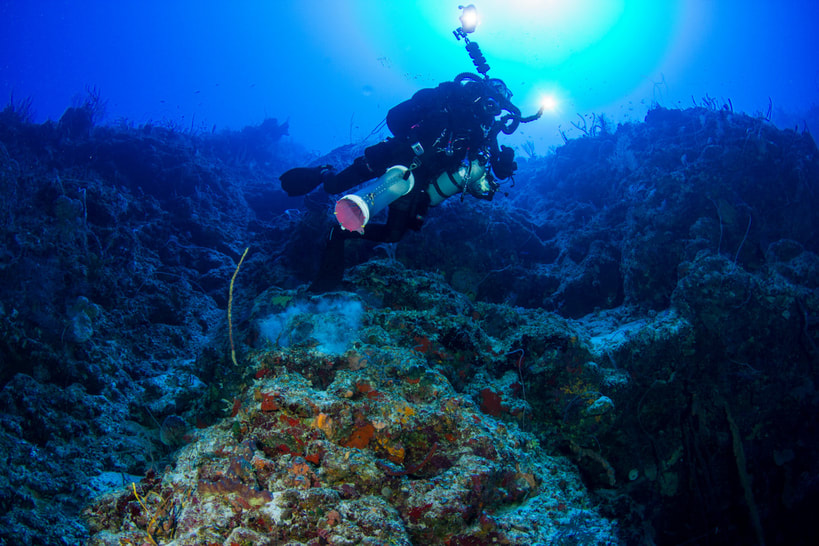
Photo courtesy of the California Academy of Sciences
The California Academy of Sciences is known for colorful and engaging displays but the latest exhibit is more than just a collection of sea creatures and bright computer graphics. It’s more like a story told to visitors as they walk through the darkened exhibit space at the academy’s Steinhart Aquarium.
“Twilight Zone: Deep Reefs Revealed,” now on display is sure to keep its audiences fascinated learning about an oceanic frontier more mysterious and unexplored than the surface of the Moon.
Like any good story, the exhibit has engaging characters who journey where no one has gone before and return to tell the tale. They are divers Luiz Rocha and Bart Shepherd, who admit that they work well together 500 feet below the surface and on dry land.
Rocha, an academy ichthyologist and Shepherd, director of Steinhart, dove into the shadowy depths in the Philippines the last two years collecting fish and corals for this display. A full size mockup of a diver in full gear is testimony to the difficulty of working at such a depth.
An elaborate black scuba outfit with multiple helium-filled tanks, depth gauges and a rebreather system confirms that this equipment is not for casual dives. It also confirms that Rocha and Shepherd are more like underwater astronauts than just scientists catching fish.
And like astronauts, the men are two of only a handful of humans who have ever ventured into these deep Mesozoic reefs. “We are part of a select group of people who have ever set eyes on these things,” Shepherd said, “They are very sensitive to light and few people will have the opportunity to see them.”
Nearby, fish and invertebrates move about in dimly lit tanks which cast a blue hue evocative of their natural environment. Shepherd pointed out a colorful comb jelly which undulated as if floating through the air. Dubbed “sea peeps” for their resemblance to Easter candy, the creatures are the first to be displayed in any aquarium outside of Japan.
Shepherd lightheartedly took issue the way the Japanese biologists obtained their jellies. “They collected them with a submarine which is cheating,” he said, “We collected ours by hand.”
Diving at 400 feet requires extensive training and certifications which most scientists are unwilling to do, Rocha said. That has allowed the dive team to collect dozens of unknown fish and coral species. While adding two similar fish collected at different times into a single tank, he noticed that the second fish had different coloring than the first; evidence of a new species.
“This is how much we don’t know about these deep reefs,” he said. “You could go there blindfold your eyes, collect things randomly and half of what you collect will be a new species.”
A long plastic cylinder in a nearby display is testament to the care the divers take in bringing live animals to the surface. Deep diving fish, which stay afloat by means of a swim bladder, will die from changes in water pressure as their bladder expands at shallower depths. Normally scientists offset the pressure by puncturing the animal’s bladder with a hypodermic needle underwater forcing bubbles out.
“Being an aquarium person since I was six years old, I don’t like poking holes in fish,” Shepherd said. The cylinder is a decompression chamber that holds the fish in two gallons of water. It is sealed at 200 feet and brought to the surface where academy staffers slowly release the pressure over several days until the fish are completely decompressed.
The exhibit is the first alteration of the aquarium since the academy building reopened in 2008. The decoration and lighting give the area a distinct atmospheric feeling unlike Steinhart’s other displays. Along with the hard science, visitors can recreate bioluminescence by waving their hands over a light display and a video game in which the player swims through the water collecting fish adds an element of fun.
But one question remains. How can the divers remain calm knowing that they are several hundred feet below the surface in such an alien environment?
Shepherd has logged more than 270 hours in the deep sea. A good dive team and experienced dive safety officer help build confidence, he says but it was not always that way.
“When I first started I had a lot of anxiety as you look over the ledge and start to make your descent. And I definitely felt that in the first deep dives but with proficiency it’s like anything else you put in the hours and you are comfortable. “
Now that’s a story.
“Twilight Zone: Deep Reefs Revealed,” now on display is sure to keep its audiences fascinated learning about an oceanic frontier more mysterious and unexplored than the surface of the Moon.
Like any good story, the exhibit has engaging characters who journey where no one has gone before and return to tell the tale. They are divers Luiz Rocha and Bart Shepherd, who admit that they work well together 500 feet below the surface and on dry land.
Rocha, an academy ichthyologist and Shepherd, director of Steinhart, dove into the shadowy depths in the Philippines the last two years collecting fish and corals for this display. A full size mockup of a diver in full gear is testimony to the difficulty of working at such a depth.
An elaborate black scuba outfit with multiple helium-filled tanks, depth gauges and a rebreather system confirms that this equipment is not for casual dives. It also confirms that Rocha and Shepherd are more like underwater astronauts than just scientists catching fish.
And like astronauts, the men are two of only a handful of humans who have ever ventured into these deep Mesozoic reefs. “We are part of a select group of people who have ever set eyes on these things,” Shepherd said, “They are very sensitive to light and few people will have the opportunity to see them.”
Nearby, fish and invertebrates move about in dimly lit tanks which cast a blue hue evocative of their natural environment. Shepherd pointed out a colorful comb jelly which undulated as if floating through the air. Dubbed “sea peeps” for their resemblance to Easter candy, the creatures are the first to be displayed in any aquarium outside of Japan.
Shepherd lightheartedly took issue the way the Japanese biologists obtained their jellies. “They collected them with a submarine which is cheating,” he said, “We collected ours by hand.”
Diving at 400 feet requires extensive training and certifications which most scientists are unwilling to do, Rocha said. That has allowed the dive team to collect dozens of unknown fish and coral species. While adding two similar fish collected at different times into a single tank, he noticed that the second fish had different coloring than the first; evidence of a new species.
“This is how much we don’t know about these deep reefs,” he said. “You could go there blindfold your eyes, collect things randomly and half of what you collect will be a new species.”
A long plastic cylinder in a nearby display is testament to the care the divers take in bringing live animals to the surface. Deep diving fish, which stay afloat by means of a swim bladder, will die from changes in water pressure as their bladder expands at shallower depths. Normally scientists offset the pressure by puncturing the animal’s bladder with a hypodermic needle underwater forcing bubbles out.
“Being an aquarium person since I was six years old, I don’t like poking holes in fish,” Shepherd said. The cylinder is a decompression chamber that holds the fish in two gallons of water. It is sealed at 200 feet and brought to the surface where academy staffers slowly release the pressure over several days until the fish are completely decompressed.
The exhibit is the first alteration of the aquarium since the academy building reopened in 2008. The decoration and lighting give the area a distinct atmospheric feeling unlike Steinhart’s other displays. Along with the hard science, visitors can recreate bioluminescence by waving their hands over a light display and a video game in which the player swims through the water collecting fish adds an element of fun.
But one question remains. How can the divers remain calm knowing that they are several hundred feet below the surface in such an alien environment?
Shepherd has logged more than 270 hours in the deep sea. A good dive team and experienced dive safety officer help build confidence, he says but it was not always that way.
“When I first started I had a lot of anxiety as you look over the ledge and start to make your descent. And I definitely felt that in the first deep dives but with proficiency it’s like anything else you put in the hours and you are comfortable. “
Now that’s a story.




